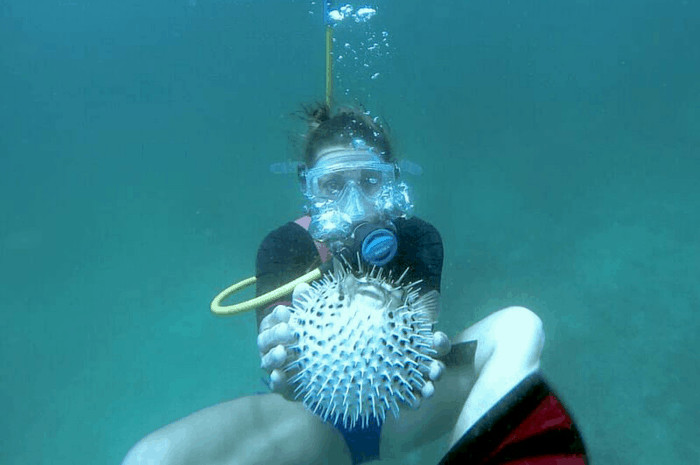April diving in Costa Rica usually reveals two oceans’ worth of diving. This is one of the best months to find favorable conditions on both coasts, offering an excellent chance to contrast the coral-reef diversity of the Caribbean with the big-numbers productivity of the Pacific. You can arrive at one ocean with your wet suit still damp from the other.
Summer dependably comes to the southern Caribbean coast twice a year, more or less. April frequently produces excellent diving conditions that last into May and sometimes June. Cahuita National Park and the Gandoca-Manzanillo National Wildlife Refuge contain hundreds of dive sites between them.
You can start with your own small coral reef surrounded by bright sand right off the beach, and then work your way to dropping a few kilometers offshore, down to the barrier reef known as Long Shoal. There, you can check out the greatest marine biodiversity in the country, with many species of coral, sponge, alga and more growing on the bottom, and a wide variety of small tropical reef fish.
A calm, clear Caribbean offers Costa Rica’s best conditions to learn how to snorkel and dive. No boat ride is necessary; just walk off the beach into what seems more like a vast swimming pool than an ocean. There are more spots right off the beaches between Punta Uva and Punta Mona than you could see in a month of diving.
Aquamor Adventures in Manzanillo is the only Environment Ministry-approved dive operator inside this protected area. Here you can get the full range of Professional Association of Diving Instructors (PADI) diving courses and certifications, from beginning open water to advanced and rescue, right up through divemaster.
When you’re ready to dive with the big boys and girls, it’s time to head to the more challenging conditions of the Pacific. Big tides and a much bigger ocean mean frequent surge and currents wash the west coast. Combine that with cool, nutrient rich water layering and swirling below warm, clear water and you get amazing productivity – meaning a lot of fish and other marine life.
What the Pacific lacks in number of species of bottom life, it makes up for with sheer numbers of things swimming around. Schools of different fish, manta rays and massive pods of dolphins might cover an area bigger than a city block. You can expect to see more fish on one Pacific dive than 10 Caribbean dives.
Guanacaste dive sites off the northern Pacific coast often start to grow clearer in April as the famous Papagayo winds begin to lie down, allowing warm surface water to stay in place over colder, green, thermocline layers. April often sees the arrival of giant mantas at the Catalina Islands, west of Flamingo.
When the winds die down, trips start to happen from all over northern Guanacaste to the Bat Islands in Santa Rosa National Park. Here is the last place in Costa Rica that offers a decent chance of seeing bull sharks.
Not so long ago, Costa Rica was famous for bull-shark sightings on many dives, at almost all sites on both coasts, but now very few of these voracious predators seem to be left. Outside of the BatIslands protected area, divemaster guides are lucky to see one or two bulls a year.
Farther south, the Nicoya Peninsula and Manuel Antonio usually find their waters clearer during April than in much of the year. Southwest of the mainland, Caño Island Biological Preserve, nearby blue-water safari areas and Cocos Island National Park lie far enough offshore of continental river sediments to boast great diving pretty much every month of the year, including this one.
You can visit Caño in a day trip from Drake Bay, on the Osa Peninsula; for Cocos, you will need at least a week at sea.






